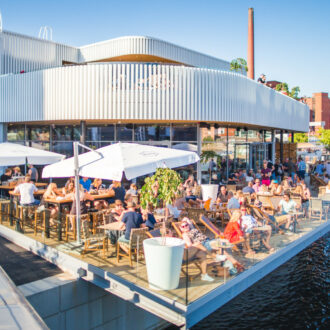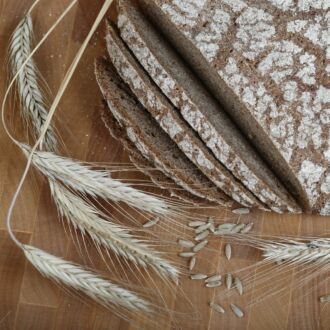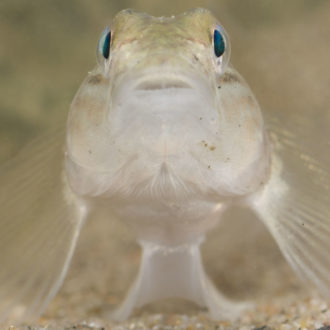With chef Marko Palovaara at the helm, Restaurant Nokka fuses organic Finnish ingredients into distinctive Christmas gourmet.
Restaurant Nokka, located in a former industrial building in the seaside neighbourhood of Katajanokka in Helsinki, draws culinary inspiration from Finland’s earthy flavours. The restaurant collaborates one-on-one with growers and fishermen around the country, and aims to ensure that even its selection of vegetables, whenever possible, comes from local sources.
In preparing Nokka’s Christmas menu, executive chef Marko Palovaara has experimented with textures and spices to add complexity to well-known recipes. At the centre of the menu, for example, is a locally grown free-range duck served with a honey-almond glaze. It’s a dish Palovaara calls “Nokka’s Christmas spectacle”.
“Our palette of flavours is very Finnish, but I still aim to bring something new into it,” Palovaara says, sitting in his restaurant during the quiet hours between lunch and dinner. “If we advertise something as rosolli [Scandinavian beet salad], it’s not necessarily made of vegetables cut into cubes and mixed with herring. Our beet salad is a mixture of pickled potato and apple with a beetroot cream, and we’ve flavoured the herring in our own way, using things like cloves.”
Ice cream in winter
Having grown up in Kolari, a town located in Finnish Lapland, Palovaara says that warm porridge in the morning and reindeer meat alongside ham at the dinner table were part of his family’s Christmas tradition – food, he adds, was a much more crucial component of the holiday than presents. Palovaara recalls one Christmas during his years as a culinary student when he decided to make spontaneous use of the minus 35 degree temperature outside to make lingonberry ice cream.
“We didn’t have an ice cream maker, so I stuck a steel bowl into the snow and came outside every 15 minutes or so to mix it,” he says with a smile. “It turned out really tasty, and quickly.”
Culinary roots

Lack of pretentiousness: The seaside setting forms the perfect place to enjoy Nokka’s palette of Finnish flavours.© Royal Restaurants
To Palovaara, Finnish Christmas food is made unique by its lack of pretentiousness, its use of simple flavours like potato, rutabaga and beetroot, and its connection to the country’s history.
“It’s wonderful that we use so many root vegetables in our Christmas food,” he says. “It’s a custom that comes from a time when Finns lived on relatively little and harvested vegetables in the fall to use throughout the winter. Of course we eat ham, which is greasy, but other than that we eat simple, healthy food during the holidays.”
“The only thing I’d change about our customs is maybe incorporate shellfish in the menu, lobster and things like that, the way Norwegians and Swedes do,” he says.
Palovaara’s duck suggestionsMousse of duck liver paté with fig compote(serves 6–8 people)
Peel and finely chop the shallots and the garlic. Glaze the livers in a pan with onions and allow them to stew until done. Do not throw away the broth. Grind the cooked livers in a food processor and flavour them with a splash of the broth in which you glazed them. Let the liver cool. Whip butter into the mixture and season it with salt and black pepper. Fig compote
Bring the white wine to a boil and add the jam sugar. Add the insides of the figs and let stew until the mixture thickens a bit. Roasted duck breast, red cabbage and cardamom sauce(6–8 people)
Make cuts into the fat of the duck and fry in a pan until crispy – begin while the pan is still cold. Roast the breast pieces in 180 degrees in the oven for about seven minutes and glaze them with honey and muesli. In order for the flavours to be absorbed, cover and let sit for 15 minutes before cutting. Cut the breast pieces into slices.
Simmer the legs in duck fat until done. Remove the bones and reshape the legs. Muesli
Roast the nuts in the oven. Mix the ingredients together and sprinkle them on top of the meat, glazed with honey. Cardamom sauce
Peel and chop the vegetables and the apples. Roast them in a splash of olive oil for a moment. Add the vinegar and reduce until almost dry. Add the red wine and allow it to boil until half of it has evaporated. Add the duck stock, sugar, cardamom, white pepper, thyme and bay leaf. Let boil for about an hour. Strain the sauce and season with salt and a piece of cold butter. Red cabbage
Grind the red cabbage with a knife. In a pot, glaze the cabbage in duck fat. Add a sliced apple and a ground onion, and let simmer for a short while. Finally, add the vinegar, the red wine and a bag of seasoning, and let stew for about an hour. |
By Laura Palotie



